In today’s competitive market, a customer-centric marketing strategy is crucial for businesses to stand out and attract new customers. One effective approach is to adopt a “Review First” marketing strategy, which prioritizes customer reviews and feedback.
By leveraging customer reviews, businesses can build trust and credibility with potential customers. A well-implemented “Review First” strategy can lead to increased customer loyalty and ultimately drive sales.

A Review First marketing strategy involves showcasing customer testimonials and reviews across various marketing channels. This approach not only enhances a business’s online reputation but also provides valuable insights into customer preferences.
Table of Contents
What is a review-first approach?
A review-first approach is a method of working in which ideas, plans, or deliverables are shared for feedback and evaluation before moving into full development or execution. Instead of waiting until a project is nearly complete to gather input, this approach prioritizes early reviews to identify potential issues, validate assumptions, and ensure alignment with goals. By inviting stakeholders to evaluate drafts, prototypes, or outlines early on, teams can make informed adjustments that save time, reduce costs, and improve quality. This collaborative and iterative process encourages transparency, builds shared ownership, and helps deliver outcomes that better meet the needs of users or clients.
Why are reviews stronger than social ads?
Reviews are often stronger than social ads because they come from real people who share genuine experiences, which makes them more trustworthy and relatable. Unlike ads, which are clearly promotional and created by brands to sell, reviews are perceived as unbiased opinions that reflect actual customer satisfaction or disappointment. This authenticity builds credibility and helps potential buyers make informed decisions, especially when they see detailed feedback or consistent positive experiences. Furthermore, reviews tap into the power of social proof—people tend to trust the collective judgment of other consumers more than a company’s marketing message. In contrast, social ads may generate awareness, but they rarely provide the depth of insight or reassurance that reviews do, making reviews a more persuasive factor in influencing purchasing behavior.
“Are you leveraging the power of customer reviews to fuel your business growth?”

In today’s digital-first marketplace, trust is currency, and nothing builds credibility faster than the authentic voices of your satisfied customers. A “Review First” marketing strategy is more than a trend—it’s a game-changing approach that transforms ordinary feedback into extraordinary business opportunities. Studies show that 91% of consumers read reviews before making a purchase, and more than 85% trust them as much as personal recommendations. That means your potential customers are making decisions about your business long before they ever speak to you—based on what others are saying. By strategically collecting, showcasing, and managing reviews across key platforms like Google, social media, and industry-specific sites, you not only boost visibility but also create powerful trust signals that convert hesitant browsers into loyal buyers. At The Spingage, we help businesses like yours unlock this potential by turning customer feedback into a cornerstone of sustainable growth.
How does SpinGage make review-first marketing automatic?
SpinGage makes review-first marketing automatic by streamlining the entire process of collecting, managing, and showcasing customer feedback. Instead of relying on manual outreach or scattered review requests, the platform automates engagement with customers at key moments, prompting them to share their experiences through personalized and timely requests. Positive reviews are then highlighted across marketing channels, while constructive feedback is routed privately to help businesses improve. By integrating seamlessly with existing workflows, SpinGage ensures that authentic customer voices drive visibility, trust, and growth without requiring constant oversight from the business, effectively turning reviews into a self-sustaining marketing engine.
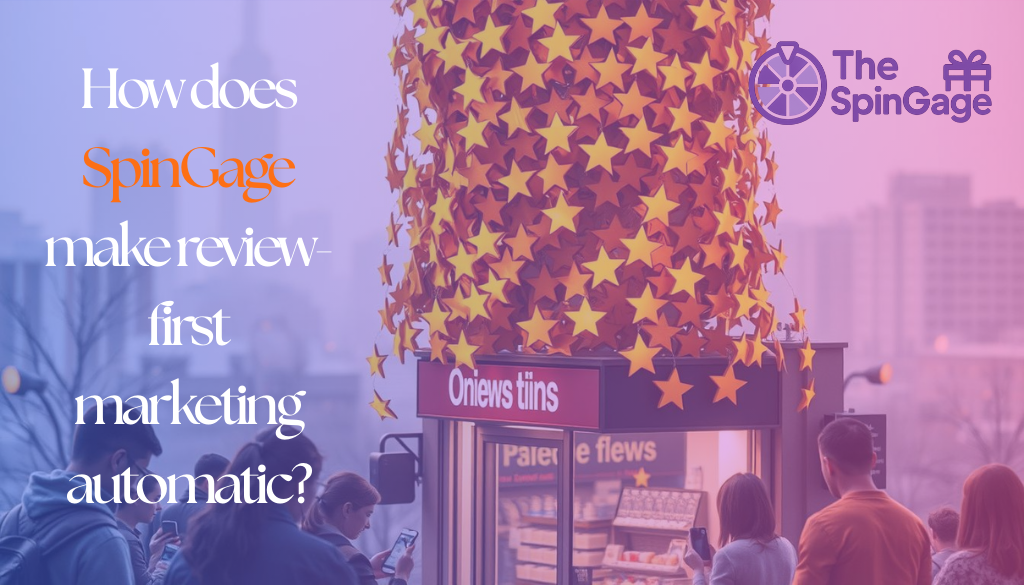
How does SpinGage automate review collection?
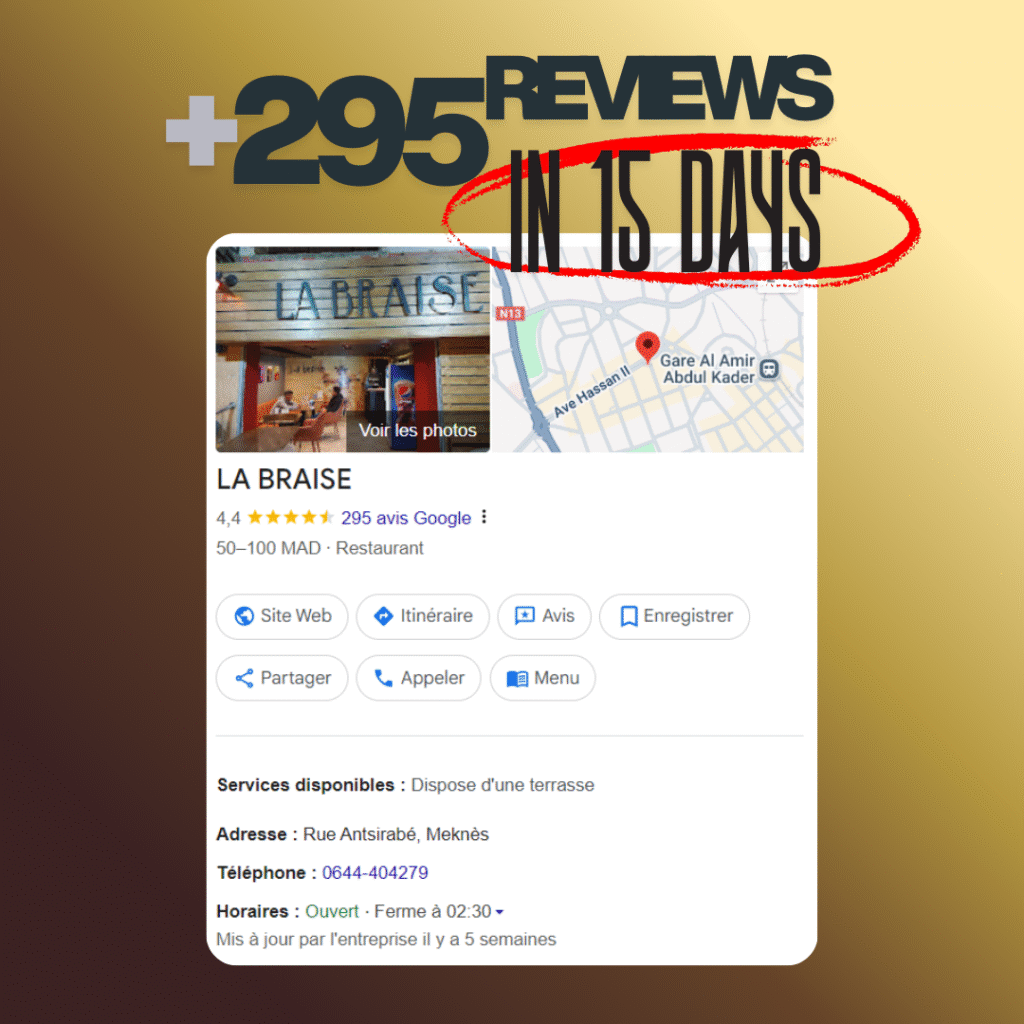
+295 REVIEWS IN JUST 15 DAYS :
Labraise is a restaurant that gained more than 295 new customer reviews and increased their income by using TheSpinGage solution.
They placed a flyer with a QR code on every table, allowing each diner to scan and spin the wheel. Labraise used a 100% winning ratio plan, where customers always won either 10% off their meal or a free soda.
This simple gamification encouraged guests to leave reviews, boosted loyalty, and kept customers coming back.

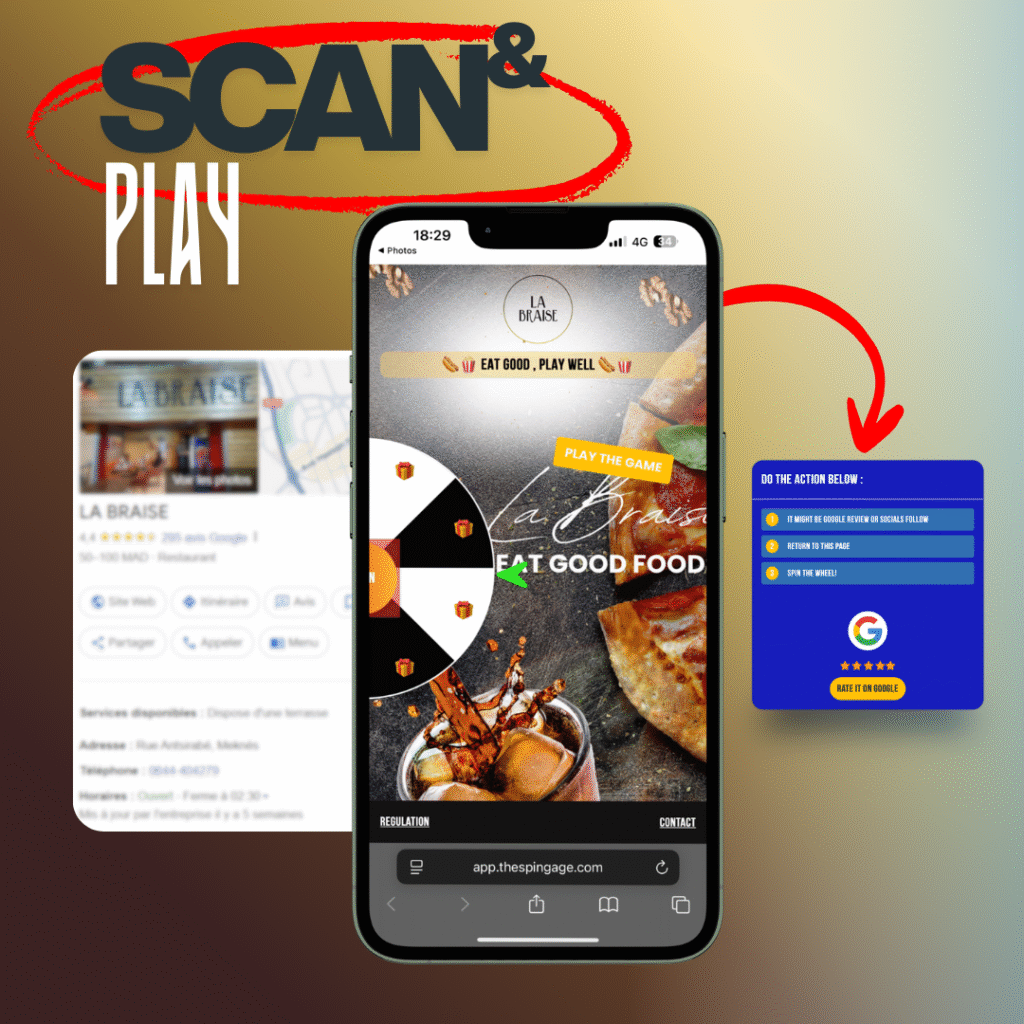
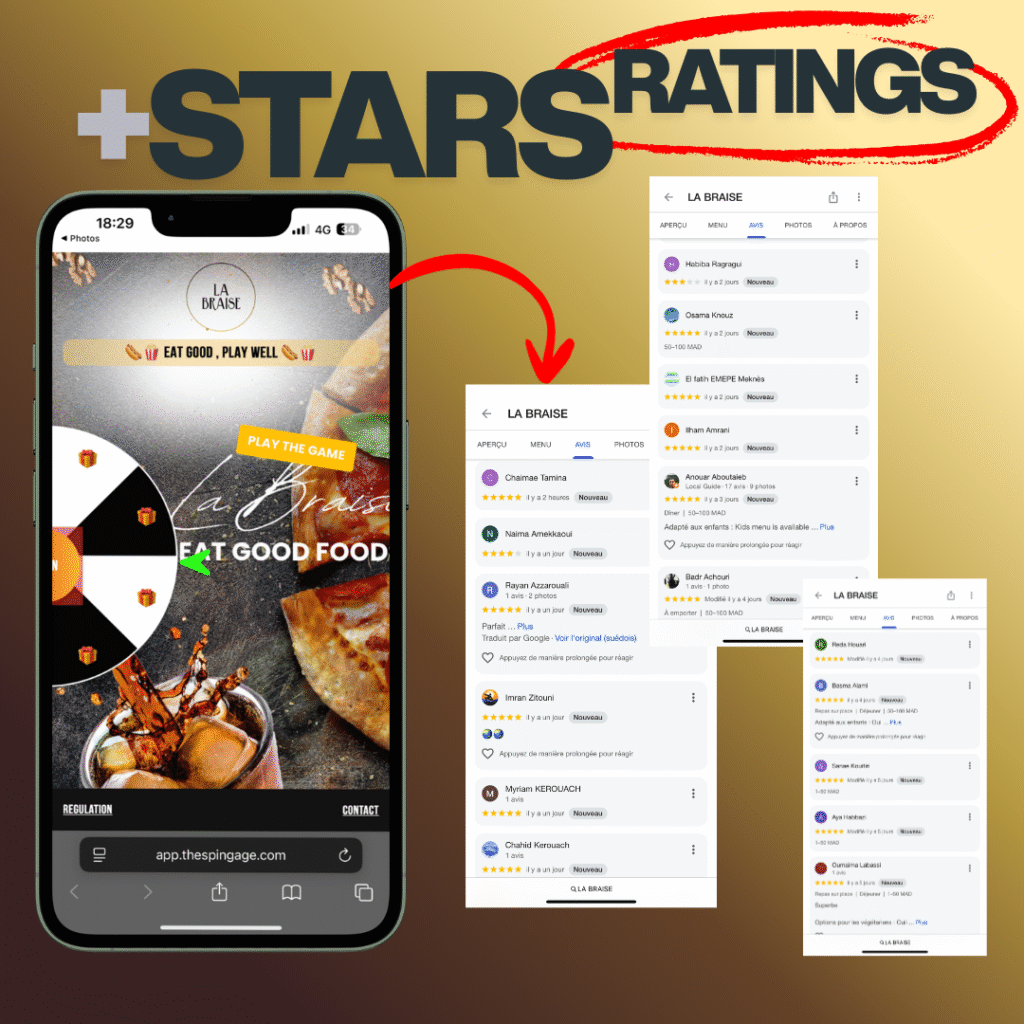
HOW IT WORKS IN 4 EASY STEPS ?
1 – Scan the QR Code
Clients simply scan the QR code placed on the table or provided directly by you.
2- Take Action First
To unlock the gameplay, they must complete the required action.
3- Spin the Wheel
Once unlocked, they spin the wheel to test their luck.
4- Win Rewards
If they win, a QR code is instantly sent to their email. If not, nothing happens. In both cases, the game is locked for 24 hours, ensuring fairness and excitement for the next try.
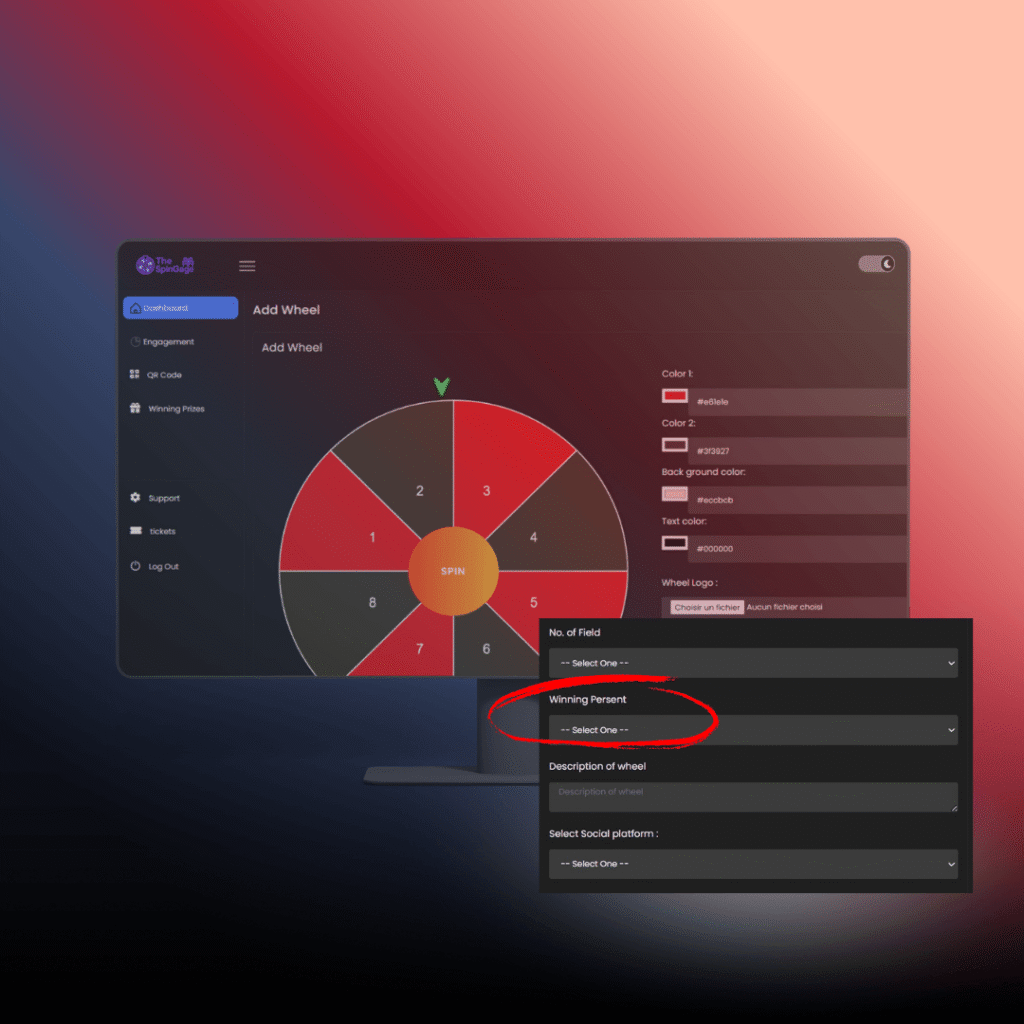



🛠️ Flexible Tracking Options
Track platform Top performing .
Track the wheel segments (number of prizes, Winner Gameplay).
Number of Plays , Track top performing wheel
Set up expiration dates for vouchers and offers.
Get Acces to LEADS , Extraxt & Modiify it .
Why You Should Opt for TheSpinGage Solution
Running a business today is not just about serving customers – it’s about creating memorable experiences that keep them coming back and spreading the word. That’s exactly what TheSpinGage delivers.
🎯 Stand Out from Your Competitors
Most restaurants, cafés, and shops rely only on discounts or word of mouth. With TheSpinGage, you turn every visit into a fun, interactive moment that clients remember and talk about.
⭐ Collect More Positive Reviews
Google reviews are the new “digital reputation.” Our system motivates clients to leave reviews in exchange for a chance to win rewards – giving you the social proof that attracts new clients effortlessly.
💌 Grow Your Customer Database
Every spin is an opportunity to collect emails and data, helping you stay connected with your clients through newsletters, promotions, and loyalty campaigns.
🔄 Boost Loyalty and Repeat Visits
Customers love rewards. By making every visit a chance to win, you encourage repeat visits, turning occasional clients into loyal fans of your business.
⚡ 100% Simple & Automated
No technical headaches. Once installed, TheSpinGage works automatically – whether through QR codes on tables, flyers, or digital screens. You just set the rules, and the system does the rest.
👉 TheSpinGage isn’t just a tool – it’s your new customer magnet.
Increase engagement, grow your reviews, and build a strong database without spending more on ads.
📲 Activate TheSpinGage today and turn visitors into loyal, returning customers!
START TODAY


SpinGage automates review collection by seamlessly integrating with your business platforms to prompt customers for feedback at the right moment. It can automatically send personalized review requests via email or SMS after a purchase or service, making it easy for customers to share their experiences. This automation not only increases the volume of reviews but also ensures consistent and timely feedback, helping businesses maintain a strong online reputation without manual effort.
Combine this with strategic local SEO practices, including keyword research, category optimization, and building citations and backlinks, and you’re positioning your business to dominate local se
Don’t leave your reputation to chance—embrace the “Review First” future of marketing and position your brand as the trusted choice in your industry.
👉 Start Building Your Review-First Strategy Today
The Power of Customer Reviews in Today’s Digital Landscape
Customer reviews have become a cornerstone in today’s digital marketplace, influencing consumer choices like never before. The way people shop and make purchasing decisions has undergone a significant transformation with the advent of the digital age.
How Reviews Shape Consumer Decisions
Consumer decisions are increasingly being shaped by the experiences and opinions of others. Customer reviews provide valuable insights into the quality and performance of a product or service, helping potential buyers make informed decisions.
Statistics on Review Influence
Studies have shown that a significant majority of consumers trust online reviews as much as personal recommendations. Here are some key statistics:
| Statistic | Percentage |
|---|---|
| Consumers who trust online reviews | 85% |
| Consumers who read reviews before making a purchase | 91% |
| Consumers who are more likely to use businesses with positive reviews | 76% |
Impact on Purchase Behavior
The influence of customer reviews on purchase behavior is profound. Positive reviews can lead to increased sales, while negative reviews can deter potential customers. Businesses must actively manage their online reputation to ensure that their products or services are well-received by consumers.

The Evolution of Word-of-Mouth in the Digital Age
The traditional word-of-mouth has evolved significantly with the rise of digital platforms. Online reviews have become a crucial aspect of marketing, allowing businesses to reach a wider audience and build trust with potential customers. As the digital landscape continues to evolve, the importance of customer reviews will only continue to grow.
Understanding the “Review First” Marketing Approach
As consumers become more discerning, the “Review First” approach offers a fresh perspective on marketing. This strategy prioritizes customer reviews and feedback as the cornerstone of marketing efforts.
Core Principles and Philosophy
The “Review First” marketing approach is built on several core principles. It emphasizes the importance of customer satisfaction and encourages businesses to validate their products or services through real customer experiences.
How It Differs from Traditional Marketing Approaches
Unlike traditional marketing, which often focuses on promotional content, the “Review First” strategy shifts the focus to customer validation. This approach is more about showcasing the value of a product or service through customer reviews.
Shifting from Promotion to Validation
By prioritizing customer reviews, businesses can move away from promotional content and towards a more authentic form of marketing. This helps build trust with potential customers.
Customer-Centric vs. Product-Centric
A “Review First” strategy is inherently customer-centric. It focuses on the needs and experiences of the customers, rather than just highlighting the features of a product.
This approach not only enhances customer engagement but also fosters a more loyal customer base.
The Psychology Behind Customer Reviews
Customer reviews have become a pivotal element in shaping consumer decisions, driven by psychological responses to trust signals and social proof. When potential customers read reviews, they’re not just looking at ratings; they’re seeking validation from peers who have experienced the product or service.
Trust Signals and Social Proof
Trust signals are crucial in the decision-making process. Positive reviews act as a form of social proof, indicating to potential customers that others have had a satisfactory experience. This social validation is a powerful motivator, as people tend to follow the actions of others when they’re uncertain.
Emotional Impact of Peer Recommendations
The emotional impact of peer recommendations cannot be overstated. Reviews tap into the psychological need for social validation, making potential customers more likely to trust a business with a strong review profile. The authenticity of reviews plays a significant role in this emotional connection.
Why Strangers’ Opinions Matter
Strangers’ opinions matter because they are perceived as unbiased. Potential customers trust reviews from other consumers more than they trust advertising. This trust is rooted in the belief that reviews are honest and reflect real experiences.
The Authenticity Factor
The authenticity of customer reviews is crucial. Reviews that are detailed and specific are seen as more genuine, enhancing their persuasive power. Businesses should encourage customers to share their honest experiences to build a robust and trustworthy review profile.
Why Businesses Can No Longer Ignore Online Reviews
Businesses today operate in a digital landscape where online reviews have become a crucial factor in their success or failure. The digital age has empowered consumers, giving them a voice that can significantly impact a business’s reputation and bottom line.
Statistical Evidence of Review Influence on Sales
Studies have shown that online reviews directly influence consumer purchasing decisions. A significant percentage of consumers read reviews before making a purchase, with many considering them a crucial factor in their decision-making process. The influence of reviews on sales is undeniable, with businesses that maintain a high review rating often seeing increased revenue.
The Cost of Neglecting Your Online Reputation
Neglecting online reviews can have severe consequences for businesses. This includes not just the loss of potential customers but also tangible financial losses.
Lost Opportunities and Revenue
When businesses ignore their online reviews, they miss out on opportunities to engage with customers, address concerns, and showcase their commitment to customer satisfaction. This can lead to lost revenue as dissatisfied customers take their business elsewhere.
Competitive Disadvantages
Moreover, businesses that fail to manage their online reputation effectively are at a competitive disadvantage. In a market where consumers have numerous choices, a poor online reputation can be the deciding factor that drives customers to competitors.
In conclusion, online reviews are no longer just a nicety for businesses; they are a necessity. By understanding the influence of reviews on sales and the costs associated with neglecting online reputation, businesses can take proactive steps to manage their online presence effectively.
Key Platforms for Implementing a “Review First” Strategy
Implementing a “Review First” strategy requires identifying the right platforms to maximize your online visibility and customer engagement. By focusing on key review platforms, businesses can enhance their reputation and attract more customers.
Google Business Profile and Local SEO
A Google Business Profile is crucial for local SEO, allowing businesses to appear in local search results and Google Maps. Encouraging customers to leave reviews on your Google Business Profile can significantly boost your local search visibility.
Industry-Specific Review Sites
Besides Google, there are industry-specific review sites where customers can share their experiences. For example, healthcare providers can benefit from reviews on Healthgrades, while service providers might use Yelp. Identifying the right platforms for your industry is key.
Social Media Platforms as Review Channels
Social media platforms are increasingly becoming important review channels. Facebook Recommendations and LinkedIn Testimonials allow customers to share their experiences in a more personal and engaging way.
Facebook Recommendations
Facebook’s algorithm favors businesses with positive recommendations, making it a valuable platform for review marketing. Encourage your satisfied customers to recommend your business on Facebook.
LinkedIn Testimonials
For B2B businesses, LinkedIn Testimonials provide a professional platform for showcasing customer satisfaction. They can be particularly effective for businesses offering services.

By leveraging these key platforms, businesses can implement a successful “Review First” strategy that enhances their online reputation and attracts more customers.
Building a Systematic Review Collection Process
Implementing a systematic review collection process is crucial for businesses aiming to enhance their online reputation. This process involves several key components that work together to maximize the number of reviews received while maintaining a personal touch.
Timing Your Review Requests for Maximum Response
The timing of review requests plays a significant role in determining the response rate. Businesses should request reviews when customers are most satisfied, such as immediately after a positive experience or successful transaction.
Automating Without Losing the Personal Touch
Automation can streamline the review collection process, but it’s essential to maintain a personal touch. Using automated systems that allow for customization can help businesses achieve this balance.

Training Staff to Request Reviews Effectively
Staff training is vital for effective review collection. Employees should be trained on how to ask for reviews appropriately, using scripts and templates to guide them.
Scripts and Templates
Using scripts and templates can help staff request reviews consistently and professionally. For example, a simple script might be: “We’re glad you’re satisfied with our service. Could you please share your experience on our review platform?”
Incentive Structures (Legal and Ethical)
Incentive structures can encourage customers to leave reviews. However, it’s crucial to ensure these incentives comply with legal and ethical guidelines. Offering discounts or rewards in exchange for reviews can be effective, but businesses must avoid practices that could be seen as buying reviews.
By implementing these strategies, businesses can build a systematic review collection process that enhances their online reputation and fosters customer engagement.
Leveraging Positive Reviews Across Marketing Channels
To truly leverage the power of customer feedback, businesses must integrate positive reviews across various marketing channels. This strategic approach not only enhances credibility but also significantly boosts conversion rates.
Incorporating Reviews into Website Design
One effective way to utilize positive reviews is by incorporating them into your website design. This can be achieved through:
- Strategic Placement for maximum visibility and conversion.
- Dynamic Review Widgets that showcase real-time customer feedback.
Strategic Placement for Conversion
Placing customer testimonials in strategic locations on your website can significantly enhance user experience and conversion rates. For instance, reviews on product pages can help alleviate purchase anxiety.
Dynamic Review Widgets
Using dynamic review widgets allows businesses to showcase a constant stream of fresh reviews, keeping the content relevant and engaging.
Using Reviews in Social Media Campaigns
Positive reviews can be a powerful tool in social media campaigns. By sharing customer testimonials on platforms like Facebook, Twitter, and Instagram, businesses can increase engagement and reach a wider audience.
Email Marketing with Customer Testimonials
Incorporating customer testimonials into email marketing campaigns can significantly enhance credibility and trust. By featuring real customer experiences, businesses can create a more personal connection with their subscribers.
Addressing Negative Reviews: Turning Challenges into Opportunities
Addressing negative reviews is not just about damage control; it’s an opportunity to build trust and improve customer service. In a digital age where consumer opinions are readily available, businesses must be proactive in managing their online reputation.
Response Strategies That Build Trust
Responding to negative reviews requires a thoughtful approach. It’s essential to acknowledge the customer’s concerns, show empathy, and provide a solution or explanation. This not only helps in resolving the issue at hand but also demonstrates to potential customers that the business values feedback and is committed to customer satisfaction.
Timing and Tone Considerations
The timing and tone of a response are crucial. Responding promptly shows that the business is attentive and cares about its customers. The tone should be professional and courteous, even when faced with negative or abusive feedback.
Template Responses vs. Personalization
While template responses can save time, personalization is key to showing customers that their feedback is genuinely considered. A balanced approach that uses templates as a guide but tailors the response to the specific situation can be effective.
Learning from Criticism to Improve Your Business
Negative reviews can provide valuable insights into areas where a business can improve. By analyzing criticism, businesses can identify patterns or common issues that need to be addressed to enhance customer satisfaction and loyalty.
| Aspect | Action | Benefit |
|---|---|---|
| Customer Feedback | Analyze negative reviews | Identify areas for improvement |
| Response Strategy | Respond promptly and professionally | Build trust with customers |
| Service Improvement | Implement changes based on feedback | Enhance customer satisfaction |
When and How to Take Conversations Offline
Sometimes, it’s necessary to take conversations offline to resolve issues more effectively. This should be done by inviting the customer to contact the business directly via phone or email, ensuring a more personalized and private resolution.
Measuring the Impact of Your “Review First” Strategy
The success of a “Review First” strategy hinges on its ability to drive tangible results. To understand its effectiveness, businesses must focus on specific metrics that reveal the strategy’s impact.
Key Performance Indicators to Track
To measure the impact of your “Review First” strategy, it’s essential to monitor key performance indicators (KPIs) that provide insights into its effectiveness.
Review Volume and Velocity
Tracking the number of reviews (volume) and how quickly they are received (velocity) helps businesses understand their online reputation’s growth and identify areas for improvement.
Sentiment Analysis Metrics
Analyzing the sentiment of reviews provides valuable insights into customer satisfaction and helps businesses identify trends in customer feedback.
| KPI | Description | Importance |
|---|---|---|
| Review Volume | Total number of reviews | High |
| Review Velocity | Rate at which new reviews are received | Medium |
| Sentiment Analysis | Analysis of review sentiment (positive, negative, neutral) | High |
Tools for Monitoring Review Performance
Utilizing the right tools is crucial for effectively monitoring review performance. Some popular tools include review management software and social listening platforms.
“The key to successful review management is not just collecting reviews, but analyzing and acting upon them.”
Review Management Expert
Calculating ROI from Review Management
To calculate the ROI of review management, businesses should consider both the direct and indirect benefits, such as increased sales and improved customer trust.
Case Studies: Businesses Thriving with “Review First” Marketing
Implementing a “Review First” marketing strategy has been a game-changer for numerous businesses across various industries. By prioritizing customer reviews, these companies have seen significant improvements in their online presence and overall marketing effectiveness.
Small Business Success Stories
Small businesses, in particular, have benefited from focusing on customer reviews. For instance, a local bakery in California saw a 25% increase in sales after actively collecting and showcasing customer reviews on their website and social media platforms.
- Increased customer trust through transparency
- Improved local SEO rankings
- Enhanced customer engagement
Enterprise-Level Implementation Examples
Large enterprises have also adopted “Review First” marketing strategies to great success. A notable example is a national retail chain that integrated customer reviews into their product pages, resulting in a 15% boost in conversion rates.
- Improved product page credibility
- Increased customer satisfaction
- Data-driven product improvements
Industry-Specific Applications
The “Review First” approach has been successfully applied across various industries, including retail, e-commerce, service-based businesses, and B2B companies.
Retail and E-commerce
An e-commerce platform saw a significant reduction in cart abandonment rates after implementing a review collection system that offered incentives for customers to leave feedback.
Service-Based Businesses
A law firm improved their online visibility by encouraging clients to leave reviews on Google and other relevant platforms, leading to an increase in client inquiries.
B2B Companies
A software company used customer testimonials and case studies to build credibility with potential clients, resulting in a 20% increase in sales leads.
These case studies demonstrate the versatility and effectiveness of “Review First” marketing across different business sizes and industries.
Common Pitfalls to Avoid in Review Marketing
Review marketing, when done correctly, can significantly boost a business’s online reputation, but there are several common mistakes to steer clear of. To maximize the benefits of a “Review First” marketing strategy, businesses must be aware of the potential pitfalls and take steps to avoid them.
Ethical Considerations and FTC Guidelines
One of the critical areas businesses must navigate is ethical considerations and compliance with FTC guidelines. The Federal Trade Commission (FTC) has strict rules about what is considered deceptive or unfair business practices, including the manipulation of customer reviews.
- Ensure transparency by clearly indicating if a review is incentivized.
- Comply with FTC guidelines on endorsements and testimonials.
- Avoid suppressing or manipulating negative reviews.
Avoiding Fake Reviews and Their Consequences
Fake reviews can significantly damage a business’s reputation and lead to legal consequences. It’s essential to understand the risks associated with fake reviews and how to mitigate them.
Legal Ramifications
Engaging in fake review practices can result in legal action from regulatory bodies like the FTC. Businesses found guilty may face fines and other penalties.
Reputation Damage
Beyond legal issues, fake reviews can erode customer trust. If discovered, the damage to a business’s reputation can be severe and long-lasting.
Balancing Persistence with Customer Experience
While it’s crucial to encourage customers to leave reviews, businesses must do so without being overly aggressive. Striking the right balance between persistence and respecting the customer experience is key.
- Train staff to request reviews at the right moment.
- Use multiple channels to ask for reviews, but avoid being intrusive.
- Show appreciation for customers who take the time to leave a review.
By being aware of these common pitfalls and taking proactive steps to avoid them, businesses can more effectively leverage review marketing to enhance their online reputation and attract more customers.
Conclusion: Embracing the “Review First” Future of Marketing
As we’ve explored throughout this article, adopting a “Review First” marketing strategy is no longer a choice but a necessity for businesses aiming to thrive in today’s digital landscape. By leveraging customer reviews, companies can build trust, enhance their online reputation, and drive sales.
The future of marketing is deeply intertwined with customer feedback, making it essential for businesses to prioritize review collection and management. This approach not only fosters a loyal customer base but also provides valuable insights into customer preferences and pain points.
By integrating “Review First” into their marketing strategy, businesses can stay ahead of the competition and adapt to the ever-evolving digital environment. As customer reviews continue to shape consumer decisions, embracing this “Review First” approach will be crucial for long-term success in the future of marketing.
FAQ
What is a “Review First” marketing strategy?
A “Review First” marketing strategy is an approach that prioritizes customer reviews and feedback as a central component of marketing efforts, leveraging them to build trust, credibility, and influence consumer decisions.
Why are customer reviews important in today’s digital landscape?
Customer reviews are crucial because they significantly influence consumer decisions, with statistics showing that a vast majority of consumers read reviews before making a purchase, and they play a key role in shaping purchasing behavior.
How do I implement a “Review First” strategy on key platforms?
To implement a “Review First” strategy, focus on platforms like Google Business Profile for local SEO, industry-specific review sites, and social media platforms such as Facebook and LinkedIn, where customers can leave reviews and testimonials.
What are the best practices for collecting customer reviews?
Best practices include timing review requests appropriately, automating processes while maintaining a personal touch, and training staff to request reviews effectively using scripts and templates, as well as implementing legal and ethical incentive structures.
How can I leverage positive reviews across different marketing channels?
Positive reviews can be incorporated into website design to enhance conversion, used in social media campaigns to engage audiences, and included in email marketing to build credibility with customer testimonials.
How should I address negative reviews?
Addressing negative reviews involves response strategies that build trust, such as timely and tone-appropriate responses, learning from criticism to improve the business, and knowing when to take conversations offline to resolve issues.
What are the key performance indicators to track for a “Review First” strategy?
Key performance indicators include review volume and velocity, sentiment analysis metrics, and calculating the ROI from review management efforts, which help in measuring the impact and effectiveness of the strategy.
What are common pitfalls to avoid in review marketing?
Common pitfalls include ethical considerations and adhering to FTC guidelines, avoiding fake reviews and their legal and reputational consequences, and balancing persistence with customer experience to maintain a positive online reputation.
Can you provide examples of businesses that have successfully implemented “Review First” marketing?
Yes, there are numerous case studies across various industries, including small businesses, enterprise-level implementations, and industry-specific applications in retail, e-commerce, service-based businesses, and B2B companies that have seen significant benefits from adopting “Review First” marketing strategies.



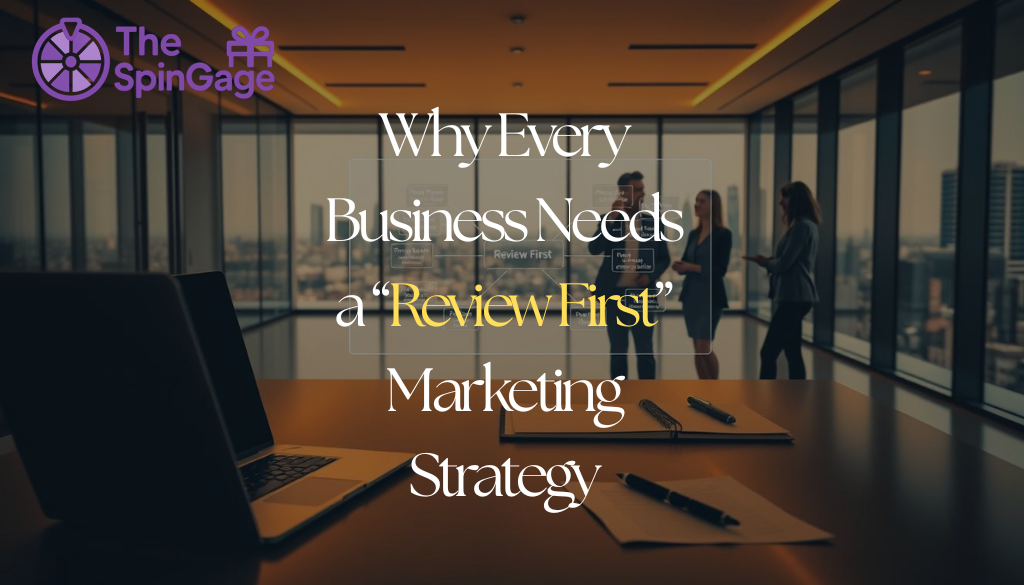


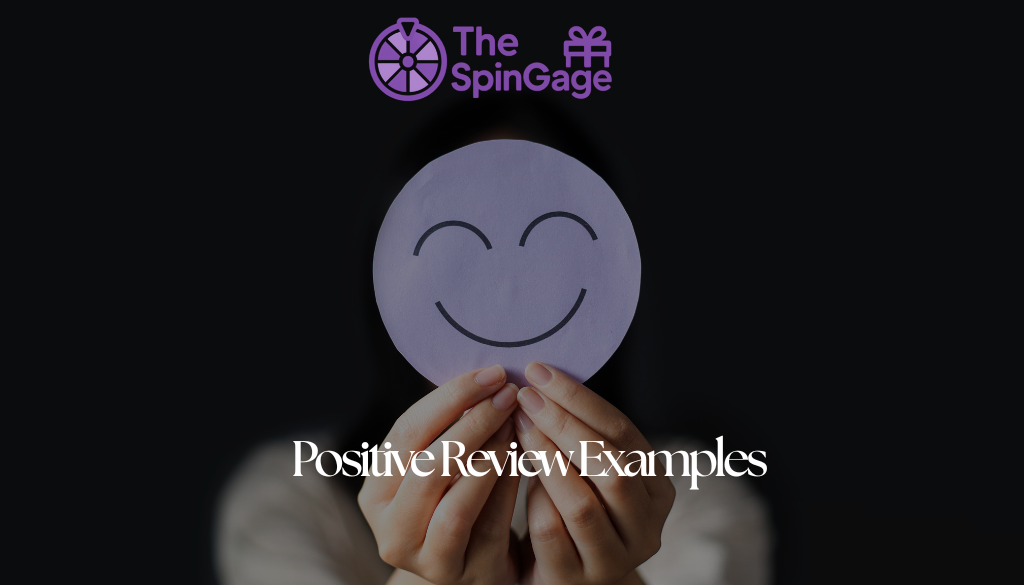





Leave a Reply